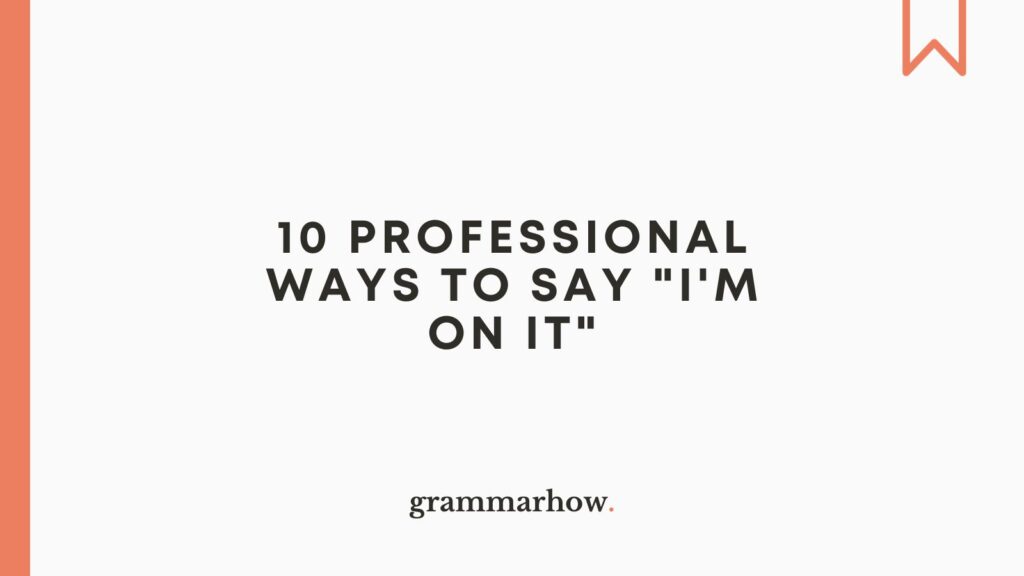So, you want to know a more professional way to say “I’m on it,” right?
After all, you’re a bit worried the phrase itself is informal or insincere.
Well, you’re in luck!
This article teaches you how to say “I’m on it” professionally.
And one of these alternatives should help you to find a more formal option:
- I’ve taken ownership of that task
- Consider it in my queue
- I’m actively working on it
- I will address that
- I’ve assumed responsibility
- I’m tackling this issue
- I’m handling the matter
- I’ve got it under control
- I’m on top of this
- I’ll address this promptly
So, keep reading to learn a formal way to say “I’m on it.” You’ll be spoilt for choice by the end of this as we dive into each alternative in more detail.
1. I’ve Taken Ownership of That Task
We want to start things off by saying that “I’ve taken ownership of that task” is a great professional synonym for “I’m on it.”
Generally, you can use this when showing how diligent and efficient you are. It’s a great way to sell yourself to an employer, as it implies that you’ll do whatever you can to get ahead.
Also, taking ownership of a task shows that you care about its outcome.
It suggests you’re the best person for the job, and you’re certain you can do things right. It will certainly impress your employer if you include it in an email to them.
So, you can check out the following email sample to learn a bit more about it:
Dear Mr. Jefferson,
Of course, I’ve taken ownership of that task.
I’ll get to work on it immediately to ensure that everything goes to plan.
Best regards,
Jon Wallace
2. Consider It in My Queue
Next, you can write “consider it in my queue.” This is a great way to sound like a go-getter. It implies that you’re diligent and ready to get to work on a task quickly.
It’s certainly worth including this when trying to impress your employer. After all, it lets them know that you don’t mess around and will begin working on something immediately.
Also, it implies you’re busier than you are. If someone is added to your “queue,” it suggests you’re already in high demand.
Therefore, even if you don’t have a lot else going on, it can make you seem more valuable. Your boss will notice this and appreciate the time you dedicate to help them.
Here’s a great email sample to help you understand it a bit better:
Dear Miss Beth,
Consider it in my queue already.
I’ll make it a top priority and get to work as soon as possible.
Yours,
Joanna Lumley
3. I’m Actively Working on It
We also think it’s smart to use “I’m actively working on it” as another way to say “I’m on it.” This is great in formal writing because it shows you’re putting effort into your work.
Most of the time, it’s a good chance to show you’re efficient and hard-working. Employers tend to respond well to these traits, which is why it’s worth including it in your writing.
Don’t just take our word for it, though. Include it in your next email to your boss.
You’ll see how quickly they latch onto this comment, especially if you’re willing to prove yourself to them and do whatever tasks they ask.
Also, you can check out the following email sample to learn more:
Dear Mr. Southside,
I’m actively working on it while you email me.
Please let me know if there’s anything else you want from me while I complete this.
All the best,
Summer Fox
4. I Will Address That
Next, we recommend using “I will address that” to let an employer know you’re all over a task. It shows initiative and commitment to a task when an employer needs your help.
So, you can write this when you’re happy to take on a task. It shows you’re willing to do what your boss asks of you, which can put you in your boss’s good books.
Generally, this is an excellent way to show that you’re reliable and trustworthy. They may be more likely to come back to you when they have other important tasks that need doing.
You can also review this email sample to learn more about how it works:
Dear Miss Momo,
I will address that immediately to help you.
Please let me know if there’s anything else I should know before we continue.
Yours,
Tony Shaw
5. I’ve Assumed Responsibility
It’s also worth writing “I’ve assumed responsibility” instead of “I’m on it.”
It’s more wordy, but that’s what makes it formal. It shows employers that you’ve taken responsibility for a task.
Generally, employers will remember this going forward. It will remind them that you’re trustworthy and able to work through something for them when required.
We recommend using it because it’s professional and sincere, too. You really can’t go wrong with something like this.
Perhaps this email sample will also help you with it:
Dear Mr. Bradshaw,
I’ve assumed responsibility for this task and will work closely with my team on it.
Please be patient while we work through it.
Yours,
Georgina Naylor
6. I’m Tackling This Issue
Next, we recommend writing “I’m tackling this issue.” It’s direct and to the point, which goes a long way when reassuring an employer that you’re on top of something.
If you “tackle” something, it means you’re coming at it from a strong angle. It means you know the best ways to get it done, and employers will see that.
So, you can use this when you’re confident in your own abilities. It suggests you have the know-how and understanding to complete a task to the best of your abilities.
Feel free to review this sample email to learn more about it:
Dear Mr. Churchley,
I’m tackling this issue as we speak.
I’ll have more news regarding this task by the end of the week.
All the best,
Joanne Clapper
7. I’m Handling the Matter
We recommend using “I’m handling the matter” as a formal way to say “I’m on it.” It’s a confident phrase that lets someone know you’re in complete control.
Generally, this will impress your boss. It shows them that you’ve got a situation completely handled, and you don’t want them to panic about putting you in charge.
Now, if you can prove that you’re in control, it’ll set you up for success moving forward. After all, your boss will see you as reliable and diligent, which goes a long way in the workplace.
Feel free to review this email sample to learn more as well:
Dear Miss Naylor,
I’m handling the matter, so please don’t worry.
I’ll be in touch as soon as I have some information that will appeal to you.
Yours,
Steven King
8. I’ve Got It Under Control
You can also say “I’ve got it under control.” Now, this is a more friendly and conversational choice that shows you’re on top of a situation.
We recommend using this when comforting a colleague. They might be struggling with a task or project and come to you for help.
Using this phrase suggests that you know exactly what to do to help them. It’s a great way to show a colleague that you’ve got their back and will do whatever you can to assist them.
Also, you can check out this email sample to learn a bit more:
Dear Matilde,
I’ve got it under control, and I’m more than happy to help you.
What else do you need from me right now?
Yours,
George Marsh
9. I’m on Top of This
Feel free to write “I’m on top of this” instead of “I’m on it.” This is a great way to be polite yet friendly when letting someone know you’ve got a situation handled.
Again, since this is a more friendly choice, it might not be suitable in all formal contexts.
Nevertheless, you can use it when writing to your boss. It works best if you have a good working relationship with them and know that they don’t mind some more informal writing.
After all, it’s still an effective and confident way to show someone that you’re in charge of a situation.
Frankly, you can’t go wrong with it when you know the recipient well.
Here’s an email sample to help you if you still need it:
Dear Mr. Jenkins,
I’m on top of this, so don’t worry.
I’ll let you know as soon as I’ve made any developments.
Best regards,
Don Blank
10. I’ll Address This Promptly
Finally, you can write “I’ll address this promptly” instead of “I’m on it.”
It’s a great way to sound professional and direct when letting someone know you’ll sort something out for them.
Try using it when confirming a task with your boss. It shows you’re in control of the situation and will do what you can to complete it to help them.
Feel free to review this email sample to learn a bit more about how to use it:
Dear Mrs. Pyke,
I’ll address this promptly and get back to you soon.
I look forward to this partnership on the project.
All the best,
Matt Friend

Martin holds a Master’s degree in Finance and International Business. He has six years of experience in professional communication with clients, executives, and colleagues. Furthermore, he has teaching experience from Aarhus University. Martin has been featured as an expert in communication and teaching on Forbes and Shopify. Read more about Martin here.


